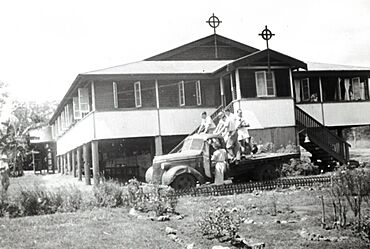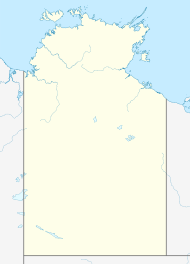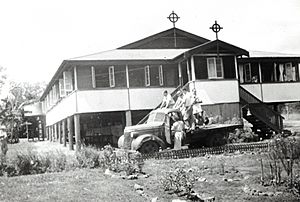Pirlangimpi facts for kids
Quick facts for kids PirlangimpiNorthern Territory |
|
|---|---|

Garden Point Mission
|
|
| Postcode(s) | 0822 |
| Elevation | 22 m (72 ft) |
| Time zone | ACST (UTC+9.5) |
| Location | 3,257 km (2,024 mi) from Canberra |
| LGA(s) | Tiwi Islands Region |
| Territory electorate(s) | Arafura |
| Federal Division(s) | Lingiari |
Pirlangimpi, once called Garden Point, is a town on Melville Island in Australia's Northern Territory. It is a significant place with a long history, especially for the local Aboriginal people.
Contents
History of Pirlangimpi
Pirlangimpi is only about 2 kilometres from Fort Dundas. This was the first place the British tried to settle in northern Australia, but it didn't last long.
The current town, then called Garden Point, started in 1937. It was set up as a police post. This was because people were worried about Japanese luggers (small fishing boats) in the area.
From 1937, some Aboriginal people from Darwin were sent to Garden Point. They were supervised by a "Control Officer."
Garden Point Mission and Its Impact
In 1939, a new government group, the Native Affairs Branch, began talking with different missions. They wanted missions to take care of children who were considered "half-caste." These children were living in government reserves like Kahlin Compound in Darwin.
It was decided that a Catholic mission would be built at Garden Point for these children. This mission was also known as Melville Island Mission or Our Lady of Victories Mission.
The Roman Catholic Missionaries of the Sacred Heart founded the mission. It was meant to be a home for children of mixed heritage. This included local children who were part-Japanese. It also included children who were removed from their families in other parts of the Northern Territory.
The Missionaries of the Sacred Heart looked after the boys. The Daughters of Our Lady of the Sacred Heart took care of the girls. Dormitories for boys and girls were ready by 1941. The boys arrived first to help with the building work.
Fifteen girls came from the mainland. Another 14 were moved from the Bathurst Island Mission. All these children were between 18 months and 14 years old. A school was also started for children aged 5 to 17.
In 1942, after Darwin was bombed during World War II, 41 children (mostly girls) were moved to Carrieton, South Australia for safety. They returned to the mission in 1945–46.
From the 1930s to the 1960s, children of Aboriginal people who had leprosy were also brought to the mission. Other children were sent there by the Welfare Branch.
The mission's lease was not renewed in 1967. This led to the mission school closing in 1968. The last children were taken back to the mainland in 1969.
Sports and Art from the Mission
Australian Rules football was brought to the mission by Brother John Pye. Three famous players who won the Norm Smith Medal grew up at the mission in Pirlangimpi. These players are Maurice Rioli, Michael Long, and Cyril Rioli.
Marjorie Liddy, who grew up at the mission, created an image that was used widely. It was featured during Pope Benedict XVI's visit to World Youth Day 2008 in Sydney.
Acknowledging Past Wrongs
Garden Point Mission was mentioned in the Bringing Them Home Report (1997). This report was the result of a national inquiry. It looked into how Aboriginal and Torres Strait Islander children were separated from their families.
Later, stories came out about the difficulties and sadness the children faced. This was because they were taken away from their families. In November 2021, the Commonwealth Government and the two churches involved formally apologised to the people who were affected. A group of affected people also reached a private agreement for compensation.
Community Facilities
As of 2016, the Pirlangimpi community has several important facilities. These include the Pularumpi primary school, a police station, and a small supermarket. There is also a club, a health facility, and an airstrip. Our Lady of Victories Catholic Church is the main church for the Melville Island area.
In 2016, the population of Pirlangimpi was 371 people.
Climate and Weather
Pirlangimpi has a tropical monsoon climate. This means it is hot all year round. There are three main seasons: the dry season, the buildup, and the wet season. The wet season usually runs from late October to April. However, it can rain during the dry season and the buildup too.
|
||||||||||||||||||||||||||||||||||||||||||||||||||||||||||||||||||||||||||||||||||||||||||||||||
| Climate data for Pirlangimpi Airport | |||||||||||||
|---|---|---|---|---|---|---|---|---|---|---|---|---|---|
| Month | Jan | Feb | Mar | Apr | May | Jun | Jul | Aug | Sep | Oct | Nov | Dec | Year |
| Record high °C (°F) | 36.4 (97.5) |
36.5 (97.7) |
36.7 (98.1) |
37.1 (98.8) |
35.8 (96.4) |
35.0 (95.0) |
35.1 (95.2) |
36.1 (97.0) |
38.3 (100.9) |
38.1 (100.6) |
38.6 (101.5) |
37.2 (99.0) |
38.6 (101.5) |
| Mean daily maximum °C (°F) | 32.1 (89.8) |
32.0 (89.6) |
32.4 (90.3) |
33.0 (91.4) |
32.8 (91.0) |
31.6 (88.9) |
31.6 (88.9) |
32.5 (90.5) |
33.7 (92.7) |
34.1 (93.4) |
34.0 (93.2) |
33.2 (91.8) |
32.8 (91.0) |
| Daily mean °C (°F) | 28.4 (83.1) |
28.3 (82.9) |
28.2 (82.8) |
28.1 (82.6) |
27.1 (80.8) |
25.3 (77.5) |
25.0 (77.0) |
25.8 (78.4) |
27.5 (81.5) |
28.6 (83.5) |
29.1 (84.4) |
29.0 (84.2) |
27.5 (81.6) |
| Mean daily minimum °C (°F) | 24.8 (76.6) |
24.6 (76.3) |
24.1 (75.4) |
23.2 (73.8) |
21.5 (70.7) |
19.0 (66.2) |
18.5 (65.3) |
19.1 (66.4) |
21.4 (70.5) |
23.1 (73.6) |
24.2 (75.6) |
24.9 (76.8) |
22.4 (72.3) |
| Record low °C (°F) | 15.4 (59.7) |
20.0 (68.0) |
18.0 (64.4) |
15.7 (60.3) |
14.0 (57.2) |
10.5 (50.9) |
11.6 (52.9) |
12.8 (55.0) |
15.9 (60.6) |
18.9 (66.0) |
17.6 (63.7) |
21.0 (69.8) |
10.5 (50.9) |
| Average rainfall mm (inches) | 414.2 (16.31) |
374.8 (14.76) |
331.9 (13.07) |
192.0 (7.56) |
22.7 (0.89) |
0.9 (0.04) |
1.8 (0.07) |
3.2 (0.13) |
22.2 (0.87) |
79.0 (3.11) |
182.2 (7.17) |
361.2 (14.22) |
1,986.1 (78.2) |
| Average rainy days | 20.9 | 20.0 | 21.3 | 13.4 | 3.9 | 0.6 | 0.8 | 1.0 | 3.1 | 8.1 | 14.8 | 19.0 | 126.9 |



